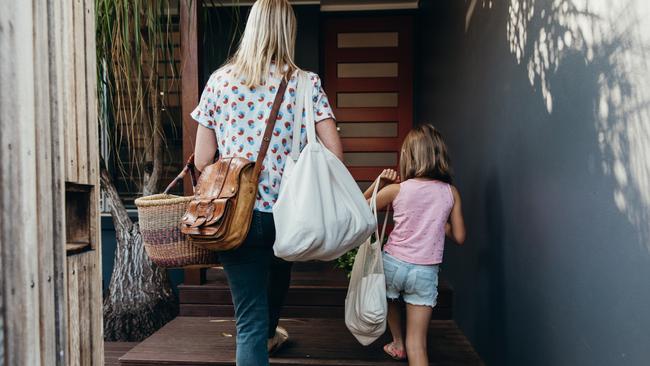Australian federal budget 2023: Biggest winners and losers explained
Labor’s 2023 budget is a great result for some Aussies but not others. See how you and your household fared.
Aussie battlers struggling to make ends meet are big winners in Labor’s budget, which comes with some tough love for middle-income households recruited into the fight against inflation and debt.
The centrepiece of the federal government’s $14.6bn cost-of-living relief package unveiled by Treasurer Jim Chalmers on Tuesday night was a $3.5bn investment to triple the bulk-billing incentive for GPs to make it cheaper for pensioners, welfare recipients and families with children aged 16 and under to visit the doctor.
A $40 fortnightly boost to Jobseeker and Youth Allowance, more support for single parents and up to $500 off energy bills for 5.5 million eligible households capped a suite of a measures carefully calibrated to reach the nation’s most vulnerable.
But it also left many other Australians to fend for themselves against a forecast 10 per cent average increase in power prices next financial year.

Despite spending that targets needy Australians, inflation is now expected to stay higher for longer, with new budget forecasts adding a quarter of a per cent to the Consumer Price Index in 2024-25.
Labor is on track to deliver a “modest” $4.2bn surplus in the 2022-23 financial year, but deficits totalling $110bn are forecast over the four-year forward estimates, while gross debt is tipped to peak at just over $1 trillion – 36.5 per cent of GDP – by 2025-26.


Dr Chalmers said Labor’s decision to bank 87 per cent of $67.2bn tax revenue windfall expected over the next two years had significantly reduced the size of deficits over the forward estimates and in turn meant the nation’s debt would peak five years earlier than was forecast in October, saving taxpayers $83bn in interest payments over the next 12 years.
Previously announced tax changes, including to superannuation balances above $3m, a 5 per cent annual increase to tax on tobacco, a 15 per cent multinational tax rate and strengthened petroleum resource rent tax were the only new revenue raising policies in the budget.
But given the increasing budget pressures from defence, health, aged care and NDIS spending, Dr Chalmers conceded the government would still need to “take tough decisions in the future”.
“Is there more work to do on the (budget) structural position, of course there is,” he said.
Asked if Labor would revisit the stage 3 tax cuts, Dr Chalmers said the government’s position on them had not changed.
He described the budget as “restrained” and said there was not “room” to “give money to every single Australian”.
But despite strict eligibility requirements for many of the direct assistance measures, he denied some households had been abandoned.
“I don’t agree with the sense that there is swathes of middle Australia who are missing out here,” he said.
Non-means-tested bulk billing for children aged 16 and below, a 15 per cent wage boost for aged-care workers, low-interest loans for households to invest in energy upgrades, more TAFE and training places, the expansion of Paid Parental Leave, and extended eligibility for the Home Guarantee Scheme to help more Australians buy their first house are among the initiatives the government says will help middle Australia.
Households not eligible for the energy relief payment – which was reserved for welfare, pension or Family Tax Benefits recipients – would still get a reduction in the expected increase to their power bills of between $238 and $530 due to the effect of the government’s cap on coal and gas prices.
Tradies were dealt a blow with a slashing of the instant asset write-off limit from $150,000 down to $20,000, but some of that pain was offset with a tax break of up to $20,000 for small businesses that make energy efficiency investments of up to $100,000.
In his second budget speech Dr Chalmers said the government’s policies would take 0.75 per cent off inflation for 2023-24, with interventions in the energy market the biggest driver of the decline.
“Because of our policies, electricity price increases are expected to be around 25 percentage points less than what was projected – and 16 percentage points less for gas,” he said.
The government will also establish a $1bn fund to provide households with low-cost loans for double glazing, solar panels and other improvements to reduce energy bills.
Dr Chalmers revealed the government would invest an additional $4bn to make Australia a “renewable energy superpower”.
This would include $2bn for the new Hydrogen Headstart program.
“Hydrogen power means Wollongong, Gladstone and Whyalla, can make and export everything from renewable energy to green steel,” he said.
The budget also includes $3.7bn for a “revamped” five-year national skills agreement with states and territories, which includes measures to attract more women into apprenticeships.
Defence headline spending will increase by $2bn in 2023-24 from $48bn to $50.1bn with greater investment in “people-to-people” programs in the Indo-Pacific to curb China’s ambition in the region.
BUDGET 2023: WINNERS AND LOSERS
The winners and losers of the government’s second budget in under a year have been revealed as Labor stresses it must prioritise vulnerable Australians in its bid to balance the books.
Treasurer Jim Chalmers said the budget would be back in the black for the first time in 15 years with a short-lived but slim surplus of about $4bn this financial year.
But with deficits predicted over the next four years and millions of Australians struggling with the rising cost of living, Dr Chalmers handed down a budget that tinkers around the edges despite the government claiming it will build “stronger foundations for a better future”.
Here’s what you need to know:
WINNERS
Medicare
Nearly 12 million Australians have been promised more free visits to the doctor under a boost to Medicare designed to convince general practitioners to bulk bill their patients. The increased incentives will be paid to GPs who bulk bill children under 16, pensioners and other concession card holders.
GPs will be able to claim the higher incentives for face-to-face consultations more than six minutes in length as well as certain telehealth consultations.

Welfare recipients
More than 1.1m Australians will have their welfare payments boosted by $40 per fortnight from September 20, should parliament agree to the measure.
Despite speculation an increase would only apply to those aged 55 and over, the raised base rate will be applied to people receiving Jobseeker, Youth Allowance, Parenting Payment (partnered), ABSTUDY, Disability Support Pension (Youth) and Special Benefit.
However, this falls short of the advice of the government’s economic equality task force that had recommend Jobseeker raise to 90 per cent of the aged pension.
Australians aged 55 and over
More than 52,000 Australians aged 55 and over will benefit from the extension of the eligibility of a higher rate in the Jobseeker payment.
From September those who have been on the welfare payment for nine or more continuous months will receive an extra $90 per fortnight. This was previously only offered to those aged 60 and over.
Single parents with kids aged 14 and under
From September, about 57,000 single parents will receive an extra $176.90 per fortnight.
After a decade of internal regret over a decision to slash welfare assistance for single parents, Labor has lifted the age cut-off from eight to 14.
Previously, nearly a quarter of a million parents – mostly women – received the payment and were forced onto the lower Jobseeker rate when their child turned eight.
However, the move falls short of the advice of the government’s economic equality task force that had recommended the age return to the original cut-off of 16.

Bill payers
A rebadged $1.5bn package, part of a deal between the states and Commonwealth last December to bring energy prices down, will flow to more than five million eligible households and one million eligible small businesses.
Relief will be applied directly to power bills as credits rather than cash in the bank to eligible people on income support, pensions, recipients of the family tax benefit A and B. But the amount you will receive will depend on what state you live in.
Small businesses with a turnover of up to $50m will be eligible for a $20,000 tax break if they invest in energy efficiency upgrades.
Renters (but only some)
The budget has forecast rents will pick up as the rental market tightens over the year. More than 1.1 million households receiving the maximum Commonwealth Rent Assistance are set to benefit when the government beefs-up the rate to 15 per cent.

Patients
Around six million Aussies with chronic health conditions will be able to buy two months worth of medicine for the price of a single script. The government says concession card holders may save up to $43.80 and general patients up to $180 per year, per medicine. The $1.2bn in savings will be reinvested in community pharmacies.
High income earners
People earning more than $120,000 will be pleased by the decision not to wind back, or tinker with, the Morrison government-era stage 3 tax cuts. Labor has been under pressure to rein in the cuts that are set to cost $20bn a year when they come into effect in 2024.
Defence workers
In a bid to slow down the retention crisis in the Australian Defence Force, a $50,000 bonus will be offered to soldiers, sailors and aviators who re-enlist for another three years.
Skilled migrants
The temporary skilled migration income threshold will be lifted from the current rate of $53,900 to $70,000, reflecting the level it would have reached if it had been indexed to wages a decade ago.

FEDERAL BUDGET 2023 LOSERS
Low and middle income earners
A Morrison government-era low and middle income tax offset (LMITO or sometimes affectionately known as “the lamington”) was not revived after being axed in the October budget. It was always designed to be temporary and replaced by the stage 2 tax cuts, but Aussies will still notice when they’re not given the break worth up to $1500 come tax time.
Middle Australia
For many who don’t have a child, aren’t on a welfare payment and are over the age of 16, they will miss out on the so-called “centrepieces” of Labor’s budget. They are ineligible for the energy bill relief, won’t benefit from the GP incentives and won’t receive any increase to rent assistance.
Homebuyers
Housing affordability issues for most Aussies looking to buy a new home will unlikely ease in the short-term. The lack of supply of homes in most markets won’t be addressed by the Government’s much-trumpeted Housing Accord - which aims to build one million “well located” homes until late 2025.

Renters
The budget papers acknowledge the increased pressure on renters, but other than an increase in payments for the most vulnerable, renters can’t expect a handout. The government says that other measures to boost the supply of housing, such as their build to rent scheme, will help boost the supply of housing.
Gas producers
Big oil and gas producers will have their tax deductions capped and face tougher tax compliance measures as part of a budget crackdown estimated by Treasury to raise $2.4bn over four years. The biggest revenue raiser out of the 16 technical petroleum resources rental tax (PRRT) changes will be limiting annual deductions for expenditure at 90 per cent of the project’s income each year from July 2023.
Vapers
A surge in young people vaping has led to the government spending $750m to combat recreational vaping. Measures include a ban on all single use and disposable vapes, a ban on the sale of vapes in convenience stores and other retail settings, targeting the black market, increasing minimum quality standards, and requiring pharmaceutical-like packaging.

Tradies
A Morrison-era Covid stimulus measure that allowed small businesses with a turnover of under $5bn to write off assets of an unlimited rate.
The measure was due to expire on June 30 and in its place is a new write off program for businesses with an annual turnover of less than $10m. It means that small businesses will be able to immediately write off eligible assets of less than $20,000. However, business owners will be able to deduct the cost of multiple eligible assets across the year. It’s understood this returns the write off measure back to pre-pandemic levels.

National Disability Insurance Scheme
Announced at the last meeting of national cabinet, the state and federal governments have agreed to cut the growth rate of the scheme from 14 per cent to 8 per cent. A package worth $732m was included in the budget over the next four years to fund staff increases and reforms required to tame costs.
Defence
More than 30 projects have been either gutted, delayed or scrapped in a bid to save $7.8bn. That funding will be reprioritised as part of a $19bn reinvestment (fully offset from Defence’s current budget) to help fund the recommendations of the Defence Strategic Review.
Ukraine
A winner in the October budget, the government hasn’t put aside any new money in aid to send to Ukraine. Instead, the budget papers say the $189.6m over two years will be met by Defence’s existing budget and “funding already provided for by the government”.
External consultants
In the wake of the scandal engulfing PWC, it’s becoming an increasingly difficult environment for government consultants.
The Budget papers reveal the government is anticipating 3300 jobs currently performed by consultants will be performed in-house in the 2023/24 financial year
- with more than 1000 to go in the Defence department alone. More than 600 contractors are expected to be discontinued in the Agriculture, Fisheries and Forestry
portfolio, while nearly 400 will go in Health and Aged Care
Dams
• $595.0 million over 7 years from 2026–27 for the Dungowan Dam project has been scrapped, as the business case did not provide sufficient support for construction of the project
• $162.5 million over 7 years from 2026–27 for the Emu Swamp Dam and Pipeline project was also scrapped. It is also being reconsidered against alternative options as part of the regional water assessment.
Originally published as Australian federal budget 2023: Biggest winners and losers explained
Read related topics:Federal Budget 2023


